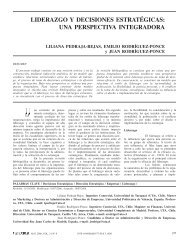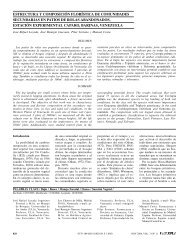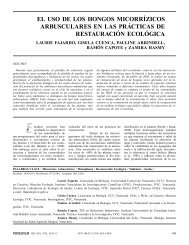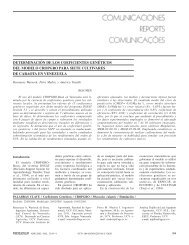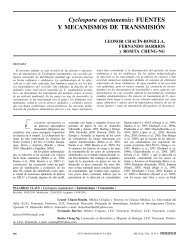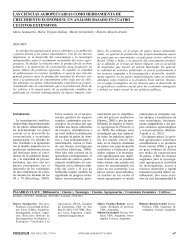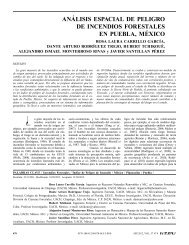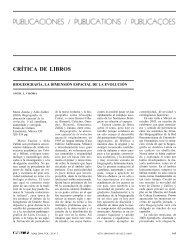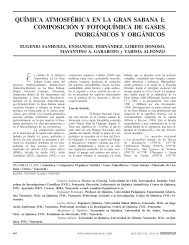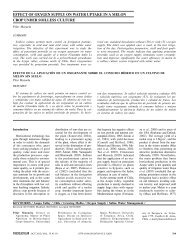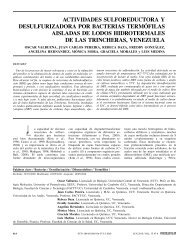EFFECTS OF MINERAL NUTRITION ON INTER- AND ... - Interciencia
EFFECTS OF MINERAL NUTRITION ON INTER- AND ... - Interciencia
EFFECTS OF MINERAL NUTRITION ON INTER- AND ... - Interciencia
You also want an ePaper? Increase the reach of your titles
YUMPU automatically turns print PDFs into web optimized ePapers that Google loves.
<strong>EFFECTS</strong> <strong>OF</strong> <strong>MINERAL</strong> <strong>NUTRITI<strong>ON</strong></strong> <strong>ON</strong> <strong>INTER</strong>- <strong>AND</strong><br />
INTRASPECIFIC <strong>INTER</strong>FERENCE <strong>OF</strong> PEANUT (Arachis hypogaea L.)<br />
<strong>AND</strong> HAIRY BEGGARTICKS (Bidens pilosa L.)<br />
Micheli Satomi Yamauti, Pedro Luis Da Costa Aguiar Alves and Silvano Bianco<br />
SUMMARY<br />
The present work was carried out to study the effects of mineral<br />
nutrition on peanut (Arachis hypogaea L) cv. IAC Runner-886<br />
and hairy beggarticks (Bidens pilosa L.) growth, when<br />
submitted to inter- and intraspecific competition. The treatments<br />
consisted of two peanut plants per pot, two hairy beggarticks<br />
per pot and one plant of each species per pot. The<br />
plants were nourished with Hoagland and Arnon (1950) complete<br />
solution, or without potassium, or without phosphorus or<br />
without nitrogen. Sixty days after planting, no inter- or intraspecific<br />
competition effect on growth characteristics of peanut<br />
was verified and nutrition was not a limiting factor to the culture.<br />
No interaction between competition and nutrition effects<br />
was observed for both species. The weed suffered more negative<br />
effects from intraspecific competition and nutrition. The<br />
absence of N had a pronounced effect compared to the other<br />
elements, resulting in a reduction in all the evaluated characteristics.<br />
The deficiency of nutrients and competition affected<br />
the weed more than the crop, showing that peanut was more<br />
competitive than hairy beggarticks.<br />
Introduction<br />
The interference of weeds<br />
represents the sum of interactions<br />
between plants, including<br />
competition and alellopathy<br />
(Rizzardi et al., 2001). It<br />
is necessary to understand the<br />
effects of each individual<br />
component of interference in<br />
order to evaluate the best<br />
strategy for weed management<br />
(Bozsa and Oliver, 1993). In<br />
the case of peanut, cv. Runner<br />
IAC 886, weed interference<br />
can reduce yield by more than<br />
80% (Nepomuceno et al.,<br />
2007; Dias et al., 2009).<br />
The level of interference<br />
can be ascertained when<br />
plants of the same species<br />
(intraspecific) or from different<br />
species (interspecific) suffer<br />
morphological and/or<br />
physiological modifications,<br />
beneficial or malefic, originating<br />
from mutual coexistence.<br />
The level of this interference<br />
can depend on planting den-<br />
sity, spacing, specific composition<br />
and distribution of<br />
plants that cohabit the same<br />
environment, among other<br />
factors (Pitelli et al., 1981;<br />
Dias et al., 2009). Clark<br />
(1971) reasoned that the more<br />
physiologically similar two<br />
species are, the more similar<br />
their need for resources and<br />
the more intense will be the<br />
interspecific competition.<br />
Among the factors that increase<br />
the level of interference<br />
between crop and weed,<br />
nutrients, principally nitrogen,<br />
phosphorus and potassium,<br />
are among the most important.<br />
However, the lack of<br />
studies related to mineral nutrition<br />
on weeds present in<br />
Brazilian crops hinders the<br />
understanding of nutritional<br />
interference factors between<br />
culture and weeds (Procópio<br />
et al., 2004). According to<br />
Marschner (1995), mineral<br />
nutrition can influence the<br />
growth and the yield of crops,<br />
causing secondary modifications<br />
on growth, morphology,<br />
anatomy and chemical composition.<br />
The importance of weed<br />
species on the level of interference<br />
is relevant because<br />
different species present a<br />
great variation on their capacity<br />
for recruitment of environmental<br />
resources, varying in<br />
form and intensity of interference<br />
on the peanut culture<br />
(Pitelli et al., 1981). Hairy<br />
beggarticks (Bidens pilosa L.)<br />
is one of the most damaging<br />
weeds found in annual and<br />
perennial crops grown in<br />
South Central Brazil (Lorenzi,<br />
2000), including peanut and<br />
crops that succeed sugarcane<br />
and no-till soybean in the<br />
State of Minas Gerais. Hairy<br />
beggarticks can produce high<br />
levels of nutrient extraction<br />
from the soil and therefore<br />
could reduce crop yield (Catunda<br />
et al., 2006). Knowledge<br />
of the biological aspects<br />
is fundamental, specially<br />
growth, nutritional requirements<br />
and responses to environmental<br />
changes, among<br />
others (Bianco et al., 2005).<br />
Research addressing the<br />
nutritional requirements of<br />
crops and weeds under interference<br />
conditions is needed<br />
in order to develop strategies<br />
of the soil nutritional state<br />
and fertilizer management<br />
aimed at increasing the competitive<br />
advantage of the crop<br />
with the weeds. The present<br />
work was carried out to study<br />
the effects of mineral nutrition<br />
on peanut (Arachis hypogaea<br />
L) ‘IAC Runner-886’<br />
and hairy beggarticks (Bidens<br />
pilosa L.) growth, when submitted<br />
to inter- and intraspecific<br />
competition.<br />
Materials and Methods<br />
The experiment was conducted<br />
from December 2007<br />
to February 2008, in a green-<br />
KEYWORDS / Competition / Nutritional Deficiency / Weed /<br />
Received: 11/03/2010. Modified: 01/04/2012. Accepted: 01/06/2012.<br />
Micheli Satomi Yamauti.<br />
Agro nomical Engineer, M.Sc.<br />
in Vegetal Production and<br />
Doctoral student in Agriculture<br />
and Applied Biology,<br />
Universidade Estadual Paulista<br />
(UNESP), Jaboticabal, Brazil.<br />
e-mail: micheliyamauti@<br />
yahoo.com.br<br />
Pedro Luis da Costa Aguiar<br />
Alves. Agronomical Engineer,<br />
UNESP. M.Sc. in Agricultural<br />
Science, Universidade<br />
Federal de Viçosa, Brazil.<br />
Ph.D. in Vegetal Biology,<br />
UNICAMP, Brazil. Professor,<br />
UNESP, Brazil. e-mail:<br />
plalves@fcav.unesp.br<br />
Silvano Bianco. Agronomical<br />
Engineer, UNESP, Brazil<br />
M.Sc. in Genetics and Plant<br />
Breeding, Universidade de<br />
São Paulo, Brazil. Ph.D. in<br />
Vegetal Production, UNESP,<br />
Brazil. Professor, UNESP,<br />
Brazil. e-mail: sbianco@<br />
fcav.unesp.br<br />
JAN 2012, VOL. 37 Nº 1<br />
0378-1844/12/01/065-05 $ 3.00/0<br />
65
EFECTOS DE LA NUTRICIÓN <strong>MINERAL</strong> EN LA COMPETENCIA <strong>INTER</strong>- E INTRAESPECÍFICA DE MANÍ (Arachis<br />
hypogaea L.) Y AMOR SECO (Bidens pilosa L.)<br />
Micheli Satomi Yamauti, Pedro Luis Da Costa Aguiar Alves y Silvano Bianco<br />
RESUMEN<br />
El presente trabajo se llevó a cabo para investigar los efectos<br />
de la nutrición mineral en el crecimiento de maní (Arachis<br />
hypogaea L.) cv. ‘Runner IAC-886’ y amor seco (Bidens pilosa<br />
L.) cuando se somete a la competencia inter- e intraespecífica.<br />
Los tratamientos consistieron en dos plantas de maní por<br />
maceta, dos de amor seco por maceta y una planta de cada<br />
especie por maceta. Las plantas fueron regadas con solución<br />
completa de Hoagland y Arnon (1950), o sin potasio, o sin fósforo<br />
o sin nitrógeno. Sesenta días después de la siembra, el<br />
crecimiento del maní no mostró efectos a los tratamientos de<br />
O presente trabalho foi realizado para investigar os efeitos<br />
da nutrição mineral no crescimento de amendoim (Arachis<br />
hypogaea L.) cv. ‘Runner IAC-886’ e picão preto (Bidens<br />
pilosa L.) quando se submete à competição inter- e<br />
intraespecífica. Os tratamentos consistiram em duas plantas<br />
de amendoim por vaso, duas de picão preto por vaso e uma<br />
planta de cada espécie por vaso. As plantas foram regadas<br />
com solução completa de Hoagland & Arnon (1950), ou sem<br />
potássio, ou sem fósforo ou sem nitrogênio. Sessenta dias<br />
depois de plantado, o crescimento do amendoim não moscompetencia<br />
inter- e intraespecífica ni a los de los de nutrición.<br />
Por el contrario, el crecimiento de la maleza mostró una<br />
respuesta negativa a la competencia intraespecífica y a las deficiencias<br />
nutricionales. No se observaron interacciones entre<br />
los tratamientos. La ausencia de N en la solución fue la que<br />
tuvo el efecto más pronunciado en comparación con los otros<br />
elementos, resultando en la reducción en todas las características<br />
evaluadas. El maní fue más competitivo que amor seco en<br />
condiciones de deficiencias nutricionales.<br />
EfeItos da nutriÇÃO mineral Na compeTIÇÃO inter- E intraespecífica de AMENDOIM (Arachis<br />
hypogaea L.) E PICÃO PRETO (Bidens pilosa L.)<br />
Micheli Satomi Yamauti, Pedro Luis Da Costa Aguiar Alves e Silvano Bianco<br />
RESUMO<br />
trou efeitos aos tratamentos de competição inter- e intraespecífica<br />
nem aos dos de nutrição. Pelo contrario, o crescimento<br />
do mato mostrou uma resposta negativa à competição<br />
intraespecífica e as deficiências nutricionais. Não se<br />
observaram interações entre os tratamentos. A ausência de<br />
N na solução foi a que teve o efeito mais pronunciado em<br />
comparação com os outros elementos, resultando na redução<br />
em todas as características avaliadas. O amendoim<br />
foi mais competitivo que picão preto em condições de deficiências<br />
nutricionais.<br />
house of the Department of<br />
Agriculture Applied Biology,<br />
School of Agricultural and<br />
Veterinary Sciences, São Paulo<br />
State University (UNESP),<br />
Jaboticabal, SP, Brazil, utilizing<br />
15 liter plastic pots containing<br />
washed and sieved<br />
sand as substrate.<br />
Hairy beggarticks seeds<br />
(achenes) were collected in<br />
infested areas in Jaboticabal,<br />
in the proximity of the University,<br />
and stored until utilized.<br />
The seeds were allowed<br />
to germinate in trays containing<br />
126 cells, using Plantmax<br />
® as substrate. The resulting<br />
seedlings were transplanted<br />
to 15 liter pots with the<br />
substrate when they presented<br />
two pairs of expanded leaves.<br />
The peanut cultivar utilized<br />
was Runner IAC-886. Peanut<br />
was sowed directly in the 15<br />
liter pots. At the occasion of<br />
the hairy beggarticks seedling<br />
transplant, the peanut presented<br />
two pairs of expanded<br />
leaves.<br />
Plants were arranged as follows:<br />
two plants of peanut/pot<br />
(intraspecific interference),<br />
two plants of hairy beggarticks/pot<br />
(intraspecific interference)<br />
and one plant of peanut<br />
to one of hairy beggarticks/pot<br />
(interspecific interference).<br />
The establishment phase<br />
was 10 days, during which<br />
time the seedlings were irrigated<br />
daily with deionized<br />
water. At the end of this period,<br />
nutrient applications<br />
were initiated: pots were irrigated<br />
with modified Hoagland<br />
and Arnon (1950) solution<br />
according with treatments,<br />
receiving 25% of the original<br />
concentration in the first seven<br />
days, and 50% of the original<br />
concentration in the following<br />
week. After this period<br />
and until the end of experimental<br />
period the plants<br />
were irrigated with a 100%<br />
solution (original concentration).<br />
The nutrient solution<br />
was applied in the morning,<br />
and during the day moisture<br />
was maintained by irrigation<br />
with deionized water, avoiding<br />
excess water.<br />
The experimental treatments<br />
consisted of the interference<br />
conditions (intra- and<br />
interspecific) with the following<br />
four mineral nutrition<br />
schemes: complete solution<br />
(C), no nitrogen (-N), no<br />
phosphorus (-P) and no potassium<br />
(-K), totalizing 8 treatments<br />
for each plant species.<br />
These treatments were established<br />
in a 2×4 factorial<br />
scheme, with four replications<br />
in a completely randomized<br />
design.<br />
At the end of 60 days of<br />
experiment management,<br />
which is a critical period for<br />
weed interference in peanut<br />
(Nepomuceno et al., 2007;<br />
Dias et al., 2009), the hairy<br />
beggarticks and peanut plants<br />
were collected and separated<br />
in roots, stems and leaves.<br />
These plant parts were<br />
washed according to procedure<br />
described by Sarruge<br />
and Haag (1974), dried at 60-<br />
70ºC for 96h, and the dry<br />
mass of the different plant<br />
parts and the total dry mass<br />
were determined. The plant<br />
material was ground and the<br />
macronutrient concentration<br />
was determined for the different<br />
plant parts except for the<br />
roots of hairy beggarticks,<br />
due to insufficient material.<br />
Height, leaf area (LI 3000A)<br />
and number of leaves were<br />
evaluated for each species.<br />
The total nitrogen (Nt) and<br />
phosphorus (P) were determined<br />
by semimicroKjedahl<br />
and colorimetric methods utilizing<br />
phosphovanadate-molybdic<br />
acid, respectively, according<br />
to Sarruge and Haag<br />
66 JAN 2012, VOL. 37 Nº 1
(1974). Potassium<br />
(K), calcium (Ca)<br />
and magnesium<br />
(Mg) were determined<br />
by atomic<br />
absortion spectrophotometry<br />
according<br />
to the method<br />
described by Jorgensen<br />
(1977). Sulfur<br />
(S) was determined<br />
by the turbidimetric<br />
method, as<br />
described by Vitti<br />
(1989). The nutrient<br />
uptake of each species<br />
was obtained<br />
by multiplying the<br />
concentration of the<br />
nutrient in the different<br />
parts of the<br />
plant by its dry<br />
mass. Nutrient uptake<br />
has been more<br />
frequently used than<br />
concentration in<br />
studies of competition<br />
between plants.<br />
This is the preferential<br />
method since<br />
some plant species<br />
can present greater<br />
nutrient concentration<br />
but, due to<br />
low biomass production,<br />
they display<br />
low concentration<br />
(Pitelli, 1985).<br />
The statistical<br />
analysis was carried<br />
out in two<br />
parts. In the first<br />
part, the analysis<br />
included the intraspecific<br />
competition<br />
of peanut and the<br />
interspecific competition<br />
with hairy beggarticks.<br />
In the second<br />
part, the analysis included<br />
the intraspecific interaction<br />
of hairy beggarticks<br />
and interspecific<br />
competition with peanut.<br />
The data were submitted<br />
to variance analysis<br />
utilizing the F test<br />
and, when pertinent,<br />
the Tukey test at a 5%<br />
level of probability to<br />
average comparison.<br />
Results and Discussion<br />
Observations on the<br />
intraspecific interaction<br />
Table I<br />
Effects of intra- and interspecific interference and mineral<br />
nutrition conditions on some characteristics of growth<br />
of Arachis hypogaea L. after 60 days of coexistence<br />
Variable<br />
Height<br />
(cm)<br />
Number<br />
of leaves<br />
Leaf area<br />
(cm 2 )<br />
Dry mass (g)<br />
Leaves Stems Roots<br />
Total dry<br />
mass (g)<br />
Interference (I)<br />
Inter 4.37 7.44 27.00 2.09 1.69 1.40 b 3.03<br />
Intra 4.58 7.73 29.08 2.21 1.83 1.68 a 3.34<br />
Nutrition (N)<br />
Complete 4.59 a 7.47 a 28.66 ab 2.14 a 1.81 a 1.54 a 3.20 a<br />
- N 4.37 a 7.96 a 30.75 a 2.24 a 1.83 a 1.57 a 3.30 a<br />
- P 4.31 a 7.23 a 24.24 b 2.02 a 1.65 a 1.45 a 2.99 a<br />
- K 4.67 a 7.68 a 28.51 ab 2.20 a 1.74 a 1.63 a 3.25 a<br />
F I 1.74 ns 0.68 ns 2.45 ns 1.43 ns 1.99 ns 9.96 ** 4.39 ns<br />
F N 0.98 ns 0.74 ns 4.27 * 0.82 ns 0.61 ns 0.70 ns 0.84 ns<br />
IxN 1.90 ns 0.09 ns 2.24 ns 0.69 ns 0.14 ns 0.48 ns 0.46 ns<br />
CV % 8.92 11.65 11.56 11.94 14.23 13.96 11.12<br />
All data transformed to √x; equal letters in a given column indicate statistically similar values; ns: not<br />
significant; *, **: significant at 5% and 1% probability level, respectively.<br />
Table II<br />
Effects of intra- and interspecific interference and mineral<br />
nutrition conditions on some growth characteristics of<br />
Bidens pilosa L. after 60 days of coexistence<br />
Variable<br />
Height<br />
(cm)<br />
Number of<br />
leaves<br />
Leaf area<br />
(cm 2 )<br />
Dry mass (g)<br />
Leaves Stems Roots<br />
Total dry<br />
mass (g)<br />
Interference (I)<br />
Inter 9.23 a 4.70 a 28.32 a 1.94 a 2.57 a 1.80 a 3.71 a<br />
Intra 7.78 b 4.01 b 21.93 b 1.50 b 1.85 b 1.35 b 2.75 b<br />
Nutrition (N)<br />
Complete 11.14 a 4.78 a 35.86 a 2.47 a 3.70 a 2.28 a 5.01 a<br />
- N 4.39 c 3.34 b 9.09 c 0.56 c 0.66 c 0.63 c 1.07 c<br />
- P 10.04 ab 4.61 a 27.77 b 1.94 b 2.35 b 1.69 b 3.49 b<br />
- K 8.45 b 4.70 a 27.78 b 1.92 b 2.12 b 1.69 b 3.33 b<br />
F I 8.63** 9.15** 11.18** 13.01** 8.50** 10.31** 10.87**<br />
F N 36.24** 8.96** 35.24** 44.76** 25.68** 23.23** 31.38**<br />
IxN 0.63 ns 0.48 ns 0.96 ns 2.36 ns 0.60 ns 1.38 ns 1.15 ns<br />
CV % 14.15 12.84 18.64 17.38 27.22 22.25 21.95<br />
All data transformed to √x; equal letters in a given column indicate statistically similar values; ns: not<br />
significant; *, **: significant at 5% and 1% probability level, respectively.<br />
Table III<br />
Effects of intra- and interspecific interference and<br />
mineral nutrition conditions on the concentration<br />
of nutrients in A. hypogaea L. at 60 days of coexistence<br />
Nutrient N P K Ca Mg S<br />
mg/plant<br />
Interference (I)<br />
Inter 270.61 a 16.19 b 84.99 b 139.22 a 58.45 a 13.27 b<br />
Intra 307.28 a 20.94 a 108.94 a 171.35 a 69.57 a 20.44 a<br />
Nutrition (N)<br />
Complete 267.42 a 19.09 ab 167.91 a 159.97 a 54.17 b 22.66 a<br />
- N 322.43 a 22.07 a 94.79 b 149.09 a 54.25 b 19.85 ab<br />
- P 258.89 a 14.43 b 68.81 b 136.10 a 67.23 ab 11.58 c<br />
- K 307.04 a 18.65 ab 56.34 b 175.97 a 80.39 a 13.33 bc<br />
F I 2.02 ns 7.11 * 5.25 * 3.62 ns 2.99 ns 17.42 **<br />
F N 1.41 ns 3.12 ns 22.84 ** 1.00 ns 3.79 * 9.34 **<br />
IxN 0.33 ns 1.72 ns 4.10 * 0.32 ns 0.51 ns 2.84 ns<br />
CV % 21.89 23.49 26.39 26.64 24.6 24.99<br />
Equal letters in a given column indicate statistically similar values; ns: not significant; *, **:<br />
significant at 5% and 1% probability level, respectively.<br />
of peanut and interspecific<br />
interaction<br />
with hairy beggarticks<br />
showed no interaction<br />
among<br />
factors at different<br />
levels of nutrition<br />
(Table I).<br />
After 60 days of<br />
coexistence, no inter-<br />
and intraspecific<br />
interference on peanut<br />
growth characteristics<br />
was observed,<br />
with the exception<br />
of root dry<br />
mass, that was low<br />
under interspecific<br />
interference, independent<br />
of nutrition<br />
(Table I). Nutrition<br />
was not a limiting<br />
factor to the crop,<br />
except for leaf area<br />
that was smaller in<br />
the absence of P<br />
than in the absence<br />
of N, independent of<br />
the interference condition.<br />
This result<br />
differed from Rodrigues<br />
Filho et al.<br />
(1988) for cv. Tatu,<br />
in which the height<br />
and the dry mass<br />
were reduced in the<br />
absence of macronutrients.<br />
This was<br />
explained as being<br />
a result of the upright<br />
characteristic<br />
of this cultivar that<br />
can result in a different<br />
response and<br />
the absence of<br />
weed interference.<br />
No meaningful intraspecific<br />
interaction for<br />
hairy beggarticks interactions<br />
or interspecific<br />
interaction with peanut<br />
was observed between<br />
the factors studied after<br />
applying different nutritional<br />
solutions for 60<br />
days (Table II). The<br />
hairy beggarticks suffered<br />
more negative effects<br />
from interference<br />
and nutrition. The intraspecific<br />
interference decreased<br />
in all characteristics<br />
analyzed, independent<br />
of the nutrition<br />
condition. Absence of N<br />
had a greater effect than<br />
JAN 2012, VOL. 37 Nº 1<br />
67
that of other elements, resulting<br />
in the reduction of all the<br />
evaluated characteristics (Table<br />
II). According to Shafiq et<br />
al. (1994), among the nutrients,<br />
greater competition between<br />
weeds and crops occurs<br />
with N. The vital importance<br />
of N is related to amino acids<br />
buildup, protein and enzymatic<br />
activity related to chlorophyll<br />
synthesis (Malavolta<br />
et al., 1989; Marschner, 1990).<br />
Procópio et al. (2004) verified<br />
that B. pilosa presents high<br />
efficiency in the utilization of<br />
absorbed N, converting it into<br />
biomass, therefore, the absence<br />
of this element can accentuate<br />
the negative effects<br />
on the weed.<br />
Nutrition deficiency and<br />
interference affected the weed<br />
more than the crop, indicating<br />
that peanut is more competitive<br />
for nutrients than hairy<br />
beggarticks (Table II).<br />
Plants that utilize resources<br />
quickly or are<br />
capable of continuing<br />
growth at low nutrient<br />
levels are ‘good competitors’<br />
(Radosevich et<br />
al., 1996). Cralle et al.<br />
(2003) also observed<br />
that wheat growth was<br />
less inhibited in deficient<br />
soil (in this case,<br />
P) than Italian ryegrass<br />
(Lolium perenne ssp.<br />
multiflorum) cultivated<br />
in the same soil.<br />
The interference altered<br />
the concentration<br />
of P, K and S in peanut<br />
plants, which was smaller<br />
with interspecific interference<br />
(Table III).<br />
Ronchi et al. (2003) observed<br />
the potential of<br />
hairy beggarticks in<br />
the reduction of the<br />
availability of nutrients<br />
to coffee trees.<br />
There was no difference<br />
related to nutrition<br />
in the concentration<br />
of N and Ca<br />
in peanut plants. The<br />
concentration of P, K<br />
and S was lower in<br />
the absence of N, P<br />
and K. The absence<br />
of K increased the<br />
concentration of Mg<br />
(Table III).<br />
Table IV<br />
Concentration of potassium in peanut<br />
as a function of nutritional conditions<br />
and intra- and interspecific condition<br />
(interaction I×N)<br />
Nutrient<br />
K, mg/plant<br />
Inter<br />
Intra<br />
Complete b 131.37 A a 204.45 A<br />
- N a 107.82 AB a 81.77 B<br />
- P a 49.05 B a 88.57 B<br />
- K a 51.74 B a 60.94 B<br />
DMS to N in I 59.84<br />
DMS to I in N 44.32<br />
Lower-case letter within each row compare the interference under each<br />
nutritional condition; upper-case letter within each column compare the<br />
nutritional conditions under each interference.<br />
Interaction was observed<br />
between the type of interference<br />
and the nutrition only for<br />
K, in which greater amounts of<br />
macronutrients were found in<br />
plants that received complete<br />
solution, with intra- and interspecific<br />
interference. Comparison<br />
of the interference effects<br />
under each nutritional condition<br />
indicated interspecific interference<br />
differences only at<br />
low concentrations of complete<br />
nutrition (Table IV).<br />
Hairy beggarticks were<br />
more affected by intraspecific<br />
Table V<br />
Effects of intra- and interspecific interference and<br />
mineral nutrition conditions on the concentration<br />
of nutrients in hairy beggarticks 60 days after<br />
coexistence<br />
Nutrient N P K Ca Mg S<br />
mg/plant<br />
Interference (I)<br />
Inter 278.865 a 20.51 a 177.91 a 190.77 a 95.45 a 12.42 a<br />
Intra 156.93 b 11.21 b 123.77 b 106.79 b 56.80 b 7.47 b<br />
Nutrition (N)<br />
Complete 345.64 a 29.38 a 383.59 a 211.24 a 94.00 a 24.90 a<br />
- N 19.46 b 2.40 c 12.71 c 13.81 b 5.38 b 0.80 c<br />
- P 247.77 a 15.50 b 132.49 b 177.24 a 98.58 a 7.11 b<br />
- K 248.71 a 16.17 b 74.56 bc 192.81 a 106.55 a 6.95 b<br />
F I 16.08 ** 12.83 ** 10.19 ** 18.85 ** 13.73 ** 12.85 **<br />
F N 20.99 ** 18.02 ** 92.04 ** 22.15 ** 20.69 ** 56.56 **<br />
IxN 2.24 ns 2.04 ns 2.91 ns 3.80 * 3.63 * 3.01 ns<br />
CV % 34.18 40.07 27.53 31.8 33.56 34.04<br />
Equal letters in a given column indicate statistically similar values; ns: not significant; *, **:<br />
significant at 5% and 1% probability level, respectively.<br />
Table VI<br />
Concentration of Ca and Mg in hairy beggarticks as<br />
a function of nutritional conditions and intraand<br />
interspecific interference (interaction I×N)<br />
Nutrients Ca, mg/plant Mg, mg/plant<br />
Inter Intra Inter Intra<br />
Complete a 249.18 A a 173.30 A a 110.92 A a 77.08 A<br />
- N a 15.89 B a 11.73 B a 6.85 B a 3.91 B<br />
- P a 212.09 A a 142.39 A a 109.93 A a 87.23 A<br />
- K a 285.90 A b 99.72 AB a 154.12 A b 58.99 AB<br />
DMS for N within I 110.79 59.75<br />
DMS for I within N 82.06 44.25<br />
Lower-case letter within each row compare the interference under each nutritional condition; uppercase<br />
letter within each column compare the nutritional conditions under each interference.<br />
interference with decreases in<br />
all macronutrient concentrations.<br />
The absence of N resulted<br />
in reduction in the<br />
concentration of all macronutrients<br />
(Table V). Procópio et<br />
al. (2004) observed that the<br />
supply of N can be more<br />
beneficial to weeds that do<br />
not belong to the Fabaceae<br />
family than to crops, therefore,<br />
the absence of N can<br />
have a greater effect on the<br />
weed than on peanut.<br />
In the interaction of interference<br />
with nutrition related<br />
to Ca and Mg, both concentrations<br />
were low in the absence<br />
of N under either inter-<br />
or intraspecific interference.<br />
The absence of K<br />
caused lower concentrations<br />
of these two macronutrients<br />
under intraspecific interference<br />
(Table VI).<br />
Hairy beggarticks accumulated<br />
greater amounts of<br />
macronutrients if compared<br />
to the peanut receiving<br />
complete solution<br />
(Tables III and V).<br />
Other research with five<br />
hairy beggartick plants<br />
per pot found relative<br />
concentrations 4, 14, 6,<br />
7 and 9 times greater<br />
for N, P, K, Ca and Mg,<br />
respectively, in the aerial<br />
part of coffee plants<br />
cultivated without weed<br />
interference (Ronchi et<br />
al., 2003). Pro có pio et<br />
al. (2005) reports that<br />
fertilizer application is<br />
more beneficial to weeds<br />
than to crops.<br />
Conclusions<br />
The weed suffered<br />
more negative effects<br />
from intraspecific interference<br />
and nutrition.<br />
The absence of nitrogen<br />
promoted more effect<br />
than other elements, resulting<br />
in decreases in<br />
all evaluated characteristics.<br />
The absence of nutrients<br />
and the interference<br />
affected the weed<br />
more than the crop,<br />
demonstrating that the<br />
crop was more competitive<br />
than hairy beggarticks.<br />
68 JAN 2012, VOL. 37 Nº 1
REFERENCES<br />
Bianco S, Tonhão MAR, Pitelli RA<br />
(2005) Crescimento e nutrição<br />
de capim-braquiária. Planta<br />
Daninha 23: 423-428.<br />
Bozsa RC, Oliver LR (1993) Shoot<br />
and root interference of common<br />
cocklebur Xanthium strumarium)<br />
and soybean (Glycine<br />
max). Weed Sci. 41: 34-37.<br />
Catunda MG, Freitas SP, Silva<br />
CMM, Carvalho AJRC, Soares<br />
LMS (2006) Interferência de<br />
plantas daninhas no acúmulo<br />
de nutrientes e no crescimento<br />
de plantas de abacaxi. Planta<br />
Daninha 24: 199-204.<br />
Clark GL (1971) Elementos de Ecologia.<br />
Omega. Barcelona, España.<br />
534 pp.<br />
Cralle HT, Fojtasek TB, Carson<br />
KH, Chandler JM, Miller TD,<br />
Senseman SA, Bovey RW,<br />
Stone MJ (2003) Wheat and<br />
italian ryegrass (Lolium multiflorum)<br />
competition as affected<br />
by phosphorus nutrition. Weed<br />
Sci. 51: 425-429.<br />
Dias TCS, Alves PLCA, Pavani<br />
MCMD, Nepomuceno MP<br />
(2009) Efeito do espaçamento<br />
na interferência das plantas<br />
daninhas na cultura do amendoim.<br />
Planta Daninha 27:<br />
221-228.<br />
Hoagland DR, Arnon DJ (1950)<br />
The Water Culture Method of<br />
Growing Plants Without Soil.<br />
University of California.<br />
Berkeley, CA, USA. 31 pp.<br />
Jorgensen SS (1977) Metodologia<br />
Utilizada para Análises Químicas<br />
de Rotina: Guia Analítico.<br />
CENA. Piracicaba, Brazil.<br />
24 pp.<br />
Lorenzi H (2000) Plantas Daninhas<br />
do Brasil: Terrestres<br />
Aquáticas, Parasitas, Tóxicas e<br />
Medicinais. 3 rd ed. Plantarum.<br />
Nova Odessa, Brazil. 440 pp.<br />
Malavolta E, Vitti CC, Oliveira<br />
SA (1989) Avaliação do Estado<br />
Nutricional de Plantas:<br />
Princípios e Aplicações. 2 nd<br />
ed. Potafós. Piracicaba, Brazil.<br />
319 pp.<br />
Marschner H (1990) Mineral Nutrition<br />
of Higher Plants. Academic<br />
Press. San Diego, CA,<br />
USA. 674 pp.<br />
Marschner H (1995) Ion uptake<br />
mechanisms of individual<br />
cells and root: short-distance<br />
transport. Ch. 2 In Mineral<br />
Nutrition of Higher Plants.<br />
Academic Press. London, UK.<br />
pp. 06-78.<br />
Nepomuceno MP, Alves PLCA,<br />
Dias TCS, Cardozo NP, Pavani<br />
MCMD (2007) Efeito da<br />
época de semeadura nas relações<br />
de interferência entre<br />
uma comunidade infestante e<br />
a cultura do amendoim. Planta<br />
Daninha 25: 481-488.<br />
Pitelli RA (1985) Interferência das<br />
plantas daninhas nas culturas<br />
agrícolas. Inf. Agropec. 11: 16-27.<br />
Pitelli RA, Ferraz EC, Marinis G<br />
(1981) Efeito do período de<br />
matocompetição sobre a produtividade<br />
do amendoim (Arachis<br />
hypogaea L.). Planta Daninha<br />
4: 110-119.<br />
Procópio SO, Santos JB, Pires FR,<br />
Silva AA, Mendonça ES<br />
(2004) Absorção e utilização<br />
do nitrogênio pelas culturas da<br />
soja e do feijão e por plantas<br />
daninhas. Planta Daninha 22:<br />
365-374.<br />
Procópio SO, Santos JB, Pires FR,<br />
Silva AA, Mendonça ES<br />
(2005) Absorção e utilização<br />
do fósforo pelas culturas da<br />
soja e do feijão e por plantas<br />
daninhas. Rev. Bras. Ciênc.<br />
Solo 29: 911-921.<br />
Radosevich SR, Holt J, Ghersa C<br />
(1996) Physiological aspects<br />
of competition. In Weed Ecology:<br />
Implication for Management.<br />
Wiley. New York, USA.<br />
pp. 217-301.<br />
Rizzardi MA, Fleck NG, Vidal<br />
RA, Merotto AJr, Agostinetto<br />
D (2001) Competição por recursos<br />
do solo entre ervas daninhas<br />
e culturas. Ciênc. Rural<br />
31: 707-714.<br />
Rodrigues Filho FSO, Feitosa CT,<br />
Gerin MAN (1988) Omissão<br />
de macronutrientes em plantas<br />
de amendoim. Bragantia 47:<br />
305-312.<br />
Ronchi CP, Terra AA, Silva AA,<br />
Ferreira LR (2003) Acúmulo de<br />
nutrientes pelo cafeeiro sob interferência<br />
de plantas daninhas.<br />
Planta Daninha 21: 219-227.<br />
Sarruge JR, Haag HP (1974) Análises<br />
Químicas em Plantas.<br />
ESALQ/USP. Piracicaba, Brazil.<br />
56 pp.<br />
Shafiq M, Hassan A, Ahmad N,<br />
Rachid A (1994) Crop yields<br />
and nutrient uptake by rainfed<br />
wheat and mungbean as affected<br />
by tillage, fertilization,<br />
and weeding. J. Plant Nutr. 17:<br />
561-577.<br />
Vitti GC (1989) Avaliação e Interpretação<br />
do Enxofre no Solo e<br />
na Planta. FUNEP. Jaboticabal,<br />
Brazil. 37 pp.<br />
JAN 2012, VOL. 37 Nº 1<br />
69



